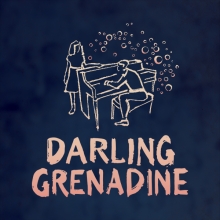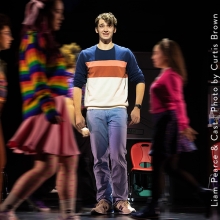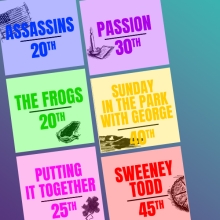
Full Synopsis
Act One
The sounds of a pier are heard, lapping water, a dock creaking, a ship's whistle, gulls' cries. The "Sailor Tango" is heard as a steamer trunk covered with travel stickers from all of Weill's journeys is revealed. A gangway descends as the "Opening Medley" plays. As "Mack the Knife" begins, the Guide enters. The music stops, and the Guide introduces himself and sets the scene: Kurt Weill has married Lotte Lenya and has begun his collaboration with Bertolt Brecht.
Four singers enter the stage, and The Threepenny Opera Sequence begins ("How to Survive – Part One," "Barbara Song," "Useless Song – Part One," "Jealousy Duet," "Useless Song – Part Two," "Mack the Knife," "How to Survive – Part Two").
The singers exit, and the Guide enters again. He takes an apron from the trunk and puts it on. The Guide introduces the Happy End Sequence as he is joined again by the singers ("March Ahead to the Fight," "Don't Be Afraid," "Bilbao Song"). As the music ends, the Guide flips a coin and asks the audience if love is worth the gamble — what if God is won in the toss? Is He your prize or your punishment? ("Surabaya Sequence," "Don't Give up the Ghost," "Childhood's Bright Endeavor"). The Guide shoos the women away and joins the male singers in "Mandalay Song."
The singers exit, and the Guide takes off his apron. We come to the City of Mahagonny. The people are disillusioned ("Alabama Song," "Deep in Alaska"). The Guide enters and announces that a hurricane is headed towards Mahagonny ("Oh, Heavenly Salvation"). The Guide enters again in the guise of a Nazi. The singers, save the Mezzo, react mechanically, as if they are puppets. They sing "As You Make Your Bed," devoid of any human emotion.
The "Pirate Jenny" Sequence begins with the Mezzo alone on stage, who sings "Pirate Jenny." In the Paris Transition Sequence, radio broadcasts in German, French and English announce that the scores of Kurt Weill and Bertolt Brecht have been burned by the Nazis, and that Brecht and Lenya have safely escaped to Paris.
The Guide introduces the Marie Galante Sequence, moving the action forward six years. We are in Paris, where Jean Cocteau muses intellectually and Josephine Baker shakes her banana-clad hips ("I Wait for a Ship"). As the "Sailor Tango" ends, the Guide calls for passengers to board the S.S. Majestic for New York. Weill and Lenya say goodbye to the old world forever.
Act Two
As the lights dim, "Love Song" is heard. The Guide enters and welcomes the audience to the United States of America. It is the tenth of September in 1935. The Guide paints a picture of New York as Weill and Lenya saw it, then turns the story back over to the singers as a new kind of sound fills the stage ("Songs of Peace and War"). War in Europe is declared, and people are enlisting to fight, but the glorious war to end all wars quickly turns to sorrow ("Hymn to Peace," "Johnny's Song").
The Knickerbocker Holiday Sequence. It is October 19, 1938. The Guide tells us that we are at the Barrymore Theatre in New York City. The singers come on stage and question what it is to be an American citizen ("How Can You Tell An American?," "September Song").
Lady in the Dark Sequence. The Guide enters. It is 1941, the year of Pearl Harbor and the fall of France. The question of American identity is answered by FDR, President of the United States — it is everyone who faces the future with confidence and courage. New York is introduced to a new spectacular: Moss Hart's Lady in the Dark ("Girl of the Moment," "Saga of Jenny," "My Ship").
The Guide opens the trunk wider. It is 1943 and Weill has taken the Oath of Citizenship, becoming a legal citizen of the United States ("Speak Low," "That's Him").
With two wars fought and won, the Guide enters into a shtick with the singers, then exits as the singers relive the Great Depression ("Progress").
Street Scene Sequence. It is 1947 and things are changing quickly on New York's Lower East Side ("Ain't It Awful, the Heat?," "Lonely House," "Lullaby").
Lost in the Stars Sequence. The Guide recounts how Weill and Maxwell Anderson collaborated on Lost in the Stars after reading Cry, the Beloved Country ("Train to Johannesburg," "Cry, the Beloved Country," "Lost in the Stars").
In the "Love Song" Sequence, the Guide tells of Weill's deteriorating health. It is April 3, 1950 ("Love Song"). As the music ends, the Guide closes with "Happy Ending" as the singers join him on stage.
Show History
Inspiration
Berlin to Broadway with Kurt Weill A Musical Voyage is a colorful cavalcade of a revue which mixes cabaret and commentary and is inspired by Weill's real life and career. The show spans a history of twenty years, from Weill's successes in Hitler's Germany to his triumphs in Truman's America, including music from such hits as The Threepenny Opera, Happy End, Knickerbocker Holiday and Lady in the Dark.
Productions
Under the direction of Donald Saddler, Berlin to Broadway with Kurt Weill opened October 1, 1972, Off-Broadway at the Theatre de Lys, which was later renamed the Lucille Lortel Theater. Covering the career of composer, Kurt Weill, using his original music, which teamed him with such renowned lyricists as Bertolt Brecht, Ira Gershwin, Alan Jay Lerner and Marc Blitzstein, among others, the show was conceived by Gene Lerner, and the cast included Margery Cohen, Judy Lander and Ken Kercheval. Berlin to Broadway with Kurt Weill played 152 performances.
In 2000, Berlin to Broadway with Kurt Weill was revived, again Off-Broadway, at the Triad Theatre in celebration of Weill s 100th birthday. The production directed by Hal Simons began previews on August 11, 2000, before officially opening on August 19, 2000, and closing on December 3, 2000, after 121 performances and ten previews.
Cultural Influence
- An album of Berlin to Broadway with Kurt Weill was recorded by the original Off-Broadway cast.
Trivia
- Kurt Weill's greatest theatrical success came after his death when The Threepenny Opera opened off-Broadway in 1954. Starring his widow, Lotte Lenya, it ran for over 2,600 performances.
Critical Reaction
"Captivating... filled with songs of great beauty and evocative power."
– New York Times
"A tuneful reminder of the German master's abundant gifts."
– Backstage
"A 20th-century treasure chest... contains an unquenchable life force."
– TheatreMania
"Experiencing Berlin to Broadway with Kurt Weill is like taking a remarkable journey across time and space, encountering some of the great literary giants of the 20th century and colliding with a few of that century's major events... a treat and honor."
– DC Theatre Scene
Connect
Lucille Lortel Archive (Original)
Lucille Lortel Archive (2000 Revival)
Billing
- Music by
- Lyrics by
- Text and Format by
Requirements
Video Warning
In accordance with the Performance License, you MUST include the following warning in all programs and in a pre-show announcement:ANY VIDEO AND/OR AUDIO RECORDING OF THIS PRODUCTION IS STRICTLY PROHIBITED.
Included Materials
| Item | Quantity Included |
|---|---|
| ERRATA LIST | 1 |
| LIBRETTO | 15 |
| PIANO CONDUCTOR'S SCORE | 2 |
| VOCAL BOOK | 15 |
Production Resources
| Resource |
|---|
| HOW DOES THE SHOW GO ON-10/CS |
| HOW DOES THE SHOW GO ON? |
| PRODUCTIONPRO-DIGITAL SCRIPT/SCORE |
| REFERENCE RECORDING |
| STAGE WRITE APPLICATION |
STANDARD ORCHESTRATION
| Instrumentation | Doubling |
|---|---|
| BASS | |
| GUITAR | BANJO , ELECTRIC GUITAR |
| PERCUSSION | TAMBOURINE , TOM TOM , TYMPANI , VIBRAPHONE , WOOD BLOCK |
| REED 1 | ALTO SAXOPHONE , CLARINET , FLUTE , SOPRANO SAX |
| TRUMPET |




